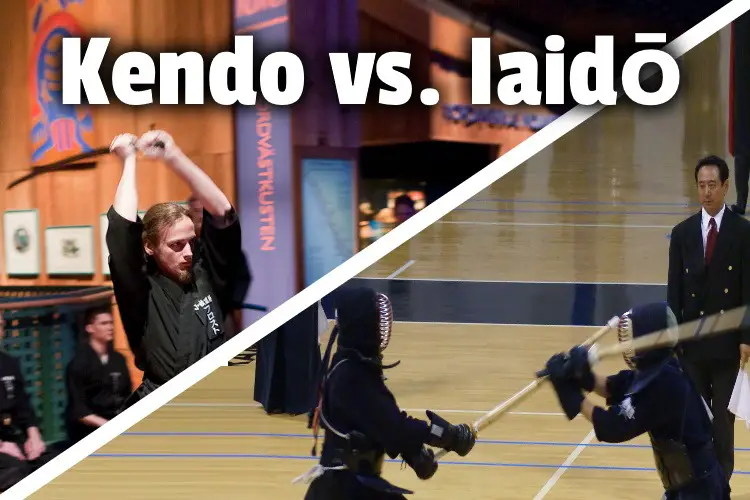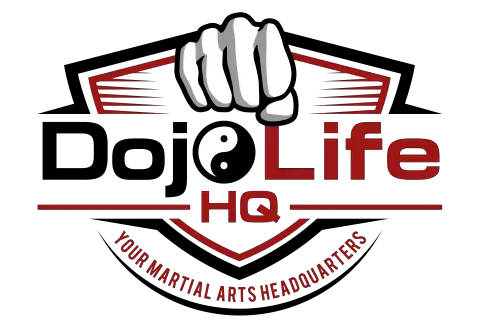
Kendo is one of the best-known Japanese sword-oriented martial arts. But there’s also Iaidō too. So today, we’ll explore the crucial differences between Kendo vs. Iaidō.
Here’s what I discovered:
Kendo differs from Iaidō in that competitions are used in Kendo, and points are scored when hits are recorded against an opponent. In Iaidō, there is no partner sparring. Instead, performances involve one person demonstrating their dexterity with how to draw a sword smoothly.
Both Iaidō and Kendo are focused on refining one’s character.
But there’s more to know. So, in this article, we’ll explore whether Iaidō is a form of Kenjutsu. We’ll also find out if it is good for self-defense. But we’ll also look at whether Kendo is like fencing.
And we’ll look at what type of swords both use to practice with. Are they “real” swords? Wooden sticks?
Let the fun begin.
A little before dinner practice time!
.
.#iaido #training #sword #practice #autumn pic.twitter.com/6yjFRtxvwf— Caryn Lix (@Missrithenay) September 17, 2019
Is Iaidō a form of Kenjutsu?
Iaidō is not a form of Kenjutsu. While Kenjutsu is an umbrella term for Japanese swordsmanship, the goal in Kenjutsu in ancient times actually used to be on killing an opponent. Iaidō, by comparison, is non-combative in nature.
Kenjutsu originated from the Samurai class.
But around 1868, this class of warriors was broken up as a more modern Japan evolved. Naturally, Kenjutsu experienced a decline. After all, it would seem crazy to walk around armed with a sword!
Iaidō, on the other hand, is the art of drawing and sheathing one’s sword.
It has devolved into a sport. But since Kenjutsu is a collective term for swordsmanship, Iaidō is almost always perceived as Kenjutsu. In point of fact, it is a “do”, not a “jutsu”.
As such, the focus is on character development, not self-defense or killing anyone.
It’s non-combative, and it’s about being present psychologically, drawing the sword, and being able to respond to sudden attacks.
In other words, Iaidō is the way of mental presence and immediate reaction. The sword drawing techniques employed in Iaidō are swift and smooth.
But, it’s vital to note that Iaidō is not sword fighting.
Iaido is a Japanese martial art which trains you, in both body and mind, how to properly use a Katana for self-defense.
+ pic.twitter.com/LHg6OimxK4— ₵ Ɇ ₦ ł ₦ (@ceninvoncatlien) December 19, 2020
Is Iaidō good for self-defense?
Iaidō is not good for self-defense as it is not designed for defense but rather for the refinement of one’s character. It’s a form of moving meditation, if you will. The focus is mindfulness and alertness. Practitioners learn how to draw their swords with utmost dexterity, but there are no contests.
So, Iaidō is not good for protecting oneself.
After all, sword fights are a thing of the past. And, in Iaidō, one is only taught how to draw the sword and cut the other in one fell swoop.
It’s about mastery, in fact, perfection.
There’s no room for error. This would be great if it were realistic. But it’s not seeing as the opponent would not sit down without protecting themselves.
Iaidō is not a martial art in the way we think of martial arts. But are martial arts worth the hassle? Yes, martial arts offer a host of benefits.
In a recent article, I looked at the key benefits and why we need to learn self-defense. But I also explored the elephant in the room: do martial arts make you violent? And I spent some time on the side effects.
Just click to read it on my site.
What it’s Like Photographing Olympic Fencing https://t.co/fqW9iMenhx #Photography pic.twitter.com/BNncOoYggj
— Green Leaf (@greenleafacd) December 12, 2016
Is Kendo like fencing?
Kendo is very much like fencing. Fencing is of Western origin, while Kendo is of Japanese ancestry. But both are alike in that the focus is to make contact with approved target areas of an opponent’s body. Scores are allocated when this is done successfully.
But there are also differences between Kendo and fencing.
Essentially, both are fencing (sports where fake swords are employed). But Kendo is a lot more than fencing. It’s a budo. So, it’s ultimately about personality improvement, while quite frankly, fencing is just a sport. There are no explicit or implicit higher aims to fencing. What you see is what you get.
Both are offshoots of swordsmanship, but fencing is fought with one hand, and it’s more graceful and more alluring.
Kendo is more intense, and it’s fought with both hands.
Both involve thrusts and strikes. In Kendo, thrusts are only allowed to the throat (tsuki), while strikes are allowed to the head (men) and to the wrist (kote), and to the body (do).
But in fencing, the strikes and thrusts allowed depend on the weapon being used.
The foil is only used for thrusts to the torso. And the fencer who starts the attack has the right of way. There’s no rule relating to the right of way in Kendo.
The epee is also a thrusting weapon that can be targeted at all parts of the opponent’s body. There’s no rule relating to the right of way when the epee is employed.
Hits are legal when they are made with the edge of a saber, and the right of way applies. The target area is anything above the waist, head and both arms included.
To know more about the similarities and crucial differences between both, check out a recent article. In it, I looked at whether fencing is like sword fighting and if Kendo is good for self-defense. But I also advised on whether it’s better to do Kendo or fencing.
Just click the link to read it on my site.
New artwork for sale! – “Kendo fighters in Shinai uniform” – https://t.co/kUL1Zam0Uc @fineartamerica pic.twitter.com/krLHaE2DxP
— SimonWestPhotography (@TinaAndSimon) December 13, 2020
Is Kendo practiced with a real sword?
As a general rule, Kendo is not practiced with real swords. Bamboo swords, known as shinai, are used for practicing. The shinai is also used in competitions. It would simply be too dangerous to use real swords.
The shinai is made of light bamboo and is often used in other martial arts too.
But it may be styled in a different manner. It evolved as a way to reduce the number of injuries that were being experienced with the former, heavier “bokuto” (hard wooden sword). Bamboo is a lot lighter than wood but strong enough to be shaped into a pseud-sword.
The shinai has four slats held together by 3 leather fillings, and all the parts are secured with a string. They are usually made from bamboo and then smoked or soaked in resin.
But some are made from reinforced or carbon fiber.
Iaido practice pic.twitter.com/4Jn3GAUCij
— Kais MEJRI (@KaisMEJRI9) October 15, 2019
How do the rules of Kendo differ from Iaidō?
Kendo differs from Iaidō in that Kendo is a competition against an opponent, and points are awarded based on hitting targets. Iaidō, however, is a solo performance of the Iaidōka’s mastery of mindfulness and alertness shown through how smoothly and swiftly they can draw and wield a sword.
The rules of Kendo relate to the kind of strikes and thrusts that are allowed and what it involves. So much so three referees oversee each contest. A strike is not valid simply because the bamboo sword touched an opponent.
At the moment of the strike, the mind and body must be integrated, so you have to stomp your foot and shout out the name of the cut the very moment you strike.
Apart from the rules relating to how to properly execute each technique, there’s the unwritten rule of always maintaining respect and decorum.
Both art forms employ swords.
But at the highest levels of Iaidō, real swords are used. This is feasible because no contest is actually going on. There are specific angles and ways the sword ought to be wielded. But because Iaidō does not involve a contest, the rules are very basic.
Conclusion
In the article, we explored whether Iaidō is a form of Kenjutsu. We also found out if it is good for self-defense. But we also looked at whether Kendo is like fencing. And we found it if Kendo is practiced with real swords.
Lastly, we saw how the rules of Kendo differ from that of Iaidō.
Photos that require attribution:
DSC_5084 by Jonas Sundberg and Kendo by Vincent Diamante are licensed under CC2.0 and were cropped, edited, merged, and had a graphic and text overlay added.
